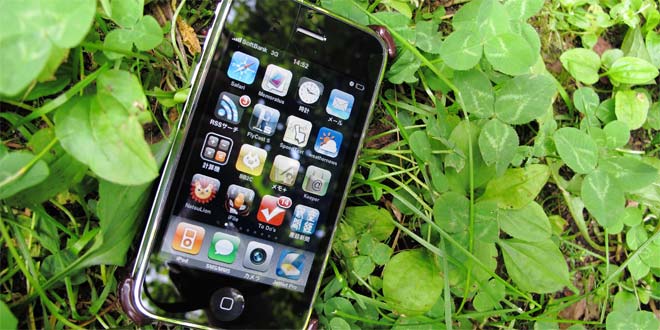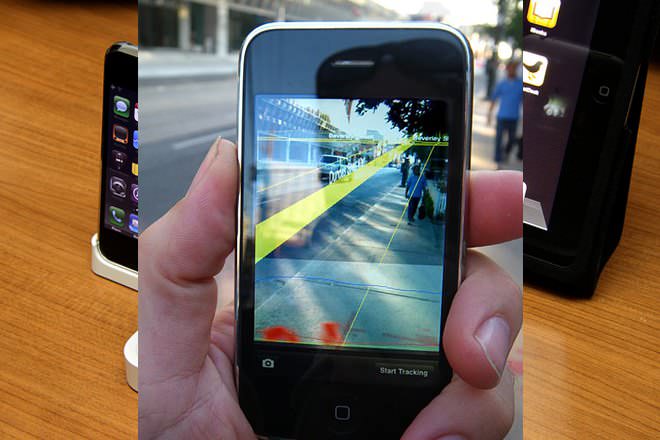On June 7, 2010, Apple announced the release of iPhone 4 at their WWDC (developer conference) with a release date of June 24, 2010. This phone and its operating system represent a marked improvement over prior versions of the iPhone. However, with the exception of FaceTime, a video calling feature enabled by the iPhone 4's front-facing camera, all other features of the new operating system - iOS 4 - will be available to iPhone 3GS users also.
Comparison chart
| | Apple iPhone 3G S | iPhone 4 |
|---|---|---|
 |  | |
| Bluetooth | Supported Profiles: HSP, HFP 1.5, PBA, A2DP version 2.1 + EDR | Supported Profiles: HSP, HFP 1.5, PBA, A2DP version 2.1 + EDR |
| Video Capture | VGA resolution, 30 fps | 720p (HD), 30 fps |
| Picture ID | Yes | Yes |
| Screen Colors | 16.7 million (24-bit) | 16.7 million (24-bit) |
| Stereo Speakers | No | No |
| Browser | Safari supports landscape mode, multi-touch zoom and pan, and multiple windows. | Safari supports landscape mode, multi-touch zoom and pan, and multiple windows. |
| Vibrate mode | Yes | Yes |
| Auto-complete suggestions for text | Yes | Yes |
| MMS | requires network support | Yes |
| Screen size | 3.5" diagonal | 3.5" diagonal |
| Networks | GSM 850 / GSM 900 / GSM 1800 / GSM 1900 WCDMA 850 / WCDMA 1900 / WCDMA 2100 | GSM 850 / GSM 900 / GSM 1800 / GSM 1900 WCDMA 850 / WCDMA 1900 / WCDMA 2100 |
| Games | Yes | Yes |
| Live TV | No | No |
| Speakerphone | Yes | Yes |
| Estimated Battery Life (Talk time) | 5 hours max. (300 minutes) | 7 hours (3G), 14 hours (2G) |
| Music Player | Supported Formats: AAC, Protected AAC, MP3, MP3 VBR, Audible 2-4, Apple Lossless, AIFF, WAV | Supported Formats: AAC, Protected AAC, MP3, MP3 VBR, Audible 2-4, Apple Lossless, AIFF, WAV |
| Java support | No | No |
| Ruggedized | No | No |
| Alarm | Yes | Yes |
| Ringer ID | Yes | Yes |
| Predecessor | iPhone 3G | iPhone 3GS |
| Screen Type | LCD (Color TFT/TFD) | LCD (Color TFT/TFD) |
| Weight | 4.76 oz (135 g) | 4.8 oz (137 g) |
| Estimated Battery Life (Standby) | 300 hours max. (12.5 days) | 300 hours max. (12.5 days) |
| SyncML | No | No |
| Screen Resolution | 320 x 480 pixels | 960 x 640 pixels |
| Calculator | Yes | Yes |
| To-Do List | No (free apps are available, however) | Yes |
| Picture messaging | Yes | Yes |
| Headset Jack (2.5 mm) | No | No |
| Voice recorder | Yes | Yes |
| Hard Drive | No | No |
| Memory card slot | No | No |
| Wireless Carrier | AT&T, Verizon, Sprint | AT&T, Verizon |
| Operating System | (proprietary) iPhone OS | iOS 4.1 |
| FM Radio | No | No |
| Languages supported | English, French, German, Traditional Chinese, Simplified Chinese, Dutch, Italian, Spanish, Portuguese, Danish, Swedish, Finnish, Norwegian, Korean, Japanese, Russian, Polish, Turkish, Ukranian, Arabic and more | English, French, German, Traditional Chinese, Simplified Chinese, Dutch, Italian, Spanish, Portuguese, Danish, Swedish, Finnish, Norwegian, Korean, Japanese, Russian, Polish, Turkish, Ukranian, Arabic and more |
| Infrared | No | No |
| Streaming Video | Protocol: H.264 / MPEG-4 (MOV, MP4, M4V, 3GPP) via Safari web browser / plus dedicated YouTube client | Protocol: H.264 / MPEG-4 (MOV, MP4, M4V, 3GPP) via Safari web browser / plus dedicated YouTube client |
| Voice dialing | Speaker-independent (automatic) | Speaker-independent (automatic) |
| Headphone Jack (3.5mm) | Yes | Yes |
| Push-To-Talk | No | No |
| Wi-Fi support | Version(s): 802.11 b/g | Version(s): 802.11b/g/n Wi-Fi (802.11n 2.4GHz only) |
| BREW | No | No |
| Physical design | Bar Internal Antenna | Bar (steel rim is the antenna) |
| Polyphonic Ringtones | No | No |
| Supports enlarging text | Yes | Yes |
| Digital TTY/TDD | Yes | Yes |
| GPS | A-GPS; photo, video geo-tagging | A-GPS; photo, video geo-tagging |
| Side buttons | volume keys, ringer switch on left / sleep key on top | volume keys, ringer switch on left / sleep key on top |
| PictBridge | No | No |
| Flashlight | No | Yes |
| Dimensions | 4.55" x 2.44" x 0.48" (116 x 62 x 12.3 mm) | 4.5" x 2.31" x 0.37" (11.2 x 58.6 x 9.3 mm) |
| E-mail client | Protocols Supported: POP, IMAP, Exchange built-in attachment viewer (Microsoft Office, PDF) | Protocols Supported: POP, IMAP, Exchange built-in attachment viewer (Microsoft Office, PDF) |
| Ringer Profiles | No | No |
| Camera | Resolution: 3+ megapixel auto-focus, with tap-to-focus control | Resolution: 5 megapixel (back-facing), LED flash, geotagging, tap to focus, also a VGA front-facing camera |
| Calendar | Yes | Yes |
| Touch Screen | Primary input method: Finger capacitive, multi-touch | Primary input method: Finger capacitive, multi-touch |
| Kickstand | No | No |
| External Display | No | No |
| CPU | 600 MHz | Apple A4 (1 GHz) |
| Manufacturer | Apple Inc. | Apple Inc. |
| Built-in memory | 32 GB (internal memory available to user for storage) or 16 GB | 32 GB (internal memory available to user for storage) or 16 GB |
| Website | http://www.apple.com/iphone/iphone-3gs/specs.html | http://www.apple.com/iphone/ |
| Form factor | Slate smartphone | Smartphone |
New Features in iPhone 4
FaceTime
FaceTime is a video chat feature available in iPhone 4. This is the biggest feature (hardware and software) that the iPhone 4 has over the 3GS. At the time of launch, this feature is only supported over Wi-Fi and only if both parties are using an iPhone. Not only does FaceTime allow users to see each other while chatting, they can also "flip" the view from the front camera to the back camera so you can show the other person what you're seeing.
Software Features
The iPhone 4 operating system is called iOS 4. All older 3GS phones were eligible for an upgrade to this new operating system. All new iPhone 3GS phones are also shipped with iOS 4. So all new features should be available to iPhone 3GS except FaceTime, which relies on the front and back cameras. The important new features in iOS 4 include:
- Multitasking with apps
- Bing as a new search option
- iBooks for the iPhone, which also supports reading PDF files
- iAds are ads inside applications that are powered by Apple's advertising network. This provides an additional revenue stream to app developers.
Hardware Features
The iPhone 4 is 24% thinner than the iPhone 3GS. It has a glass body (both front and back) and a stainless steel rim that also functions as the antenna. The glass is about 30 times harder than plastic.
Retina Display
The iPhone 4 also has what Apple calls the "retina display". The iPhone 4 screen has 326 pixels per inch, which is more pixels than the human retina can see (when the device is held 10 to 12 inches from your face). The iPhone 4 screen is 960×640 pixels, giving it four times as many pixel as the iPhone 3GS. This higher number of pixels offer a higher resolution, making pictures and text on the screen sharper. The 800:1 contrast ratio is also four times better than the iPhone 3GS.
Faster A4 processor and Larger Battery
The iPhone 4 uses the A4 chip (the same processor used by the iPad) and a larger battery. These two factors have improved battery life by as much as 40% over iPhone 3GS for talk time.
Gyroscope
Another hardware addition in the iPhone 4 is the gyroscope, a device for measuring orientation. This will make new kinds of apps possible for the iPhone 4, such as enhanced game controllers similar to the Nintendo Wii.
Camera
The back camera on the iPhone 4 is 5 megapixels (compared to 3 megapixel in the 3GS model). The iPhone 4 can also record 720p HD video at 30 frames per second. The iPhone 4 also has a front camera, which the 3GS does not have. Apple's iMovie app for the iPhone costs $4.99 and will let users edit the videos they take on the iPhone.
Antenna Problems
When the iPhone 4 was released to the public on June 24, 2010, there was a spate of antenna problems caused by holding the phone in certain ways. Because the steel rim of the phone is its antenna, holding the phone when covering certain key areas of the rim resulted in dropped calls.
Price Comparison
The iPhone 3GS now costs $149 (16 GB) and $199 for the 32 GB model. The iPhone 4 is priced at $199 (16 GB) and $299 (32 GB). Both phones are available in black or white colors and the price is the same irrespective of the color. The price requires a 2-year AT&T contract.
Data Plan Prices
As with most smartphones, the hidden cost of an iPhone is the charge that AT&T levies for data usage. All iPhones require that the customer buy a data plan. AT&T offers two data plans:
- $15 per month for 200 MB of data usage (every additional 200 MB is $15)
- $25 per month for 2 GB of data usage (every additional 1 GB is $10)
These data plans and prices are common to both the iPhone 3GS and the iPhone 4.




 iPhone 4
iPhone 4  iPhone 4
iPhone 4  Tethered Jailbreak
Tethered Jailbreak  iPhone 3GS
iPhone 3GS  HTC Incredible
HTC Incredible  Apple iPhone 3G S
Apple iPhone 3G S
Comments: Apple iPhone 3G S vs iPhone 4